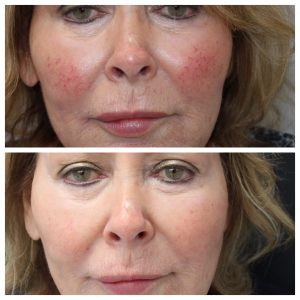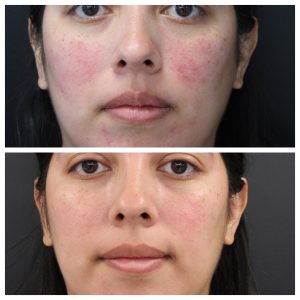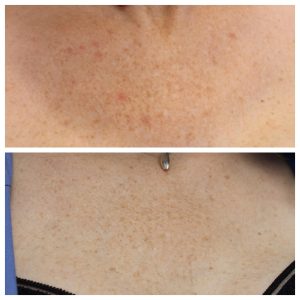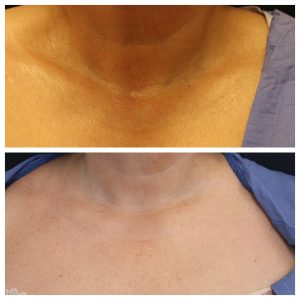Vbeam Laser for Rosacea
Conveniently located to serve the areas of Santa Monica and Los Angeles
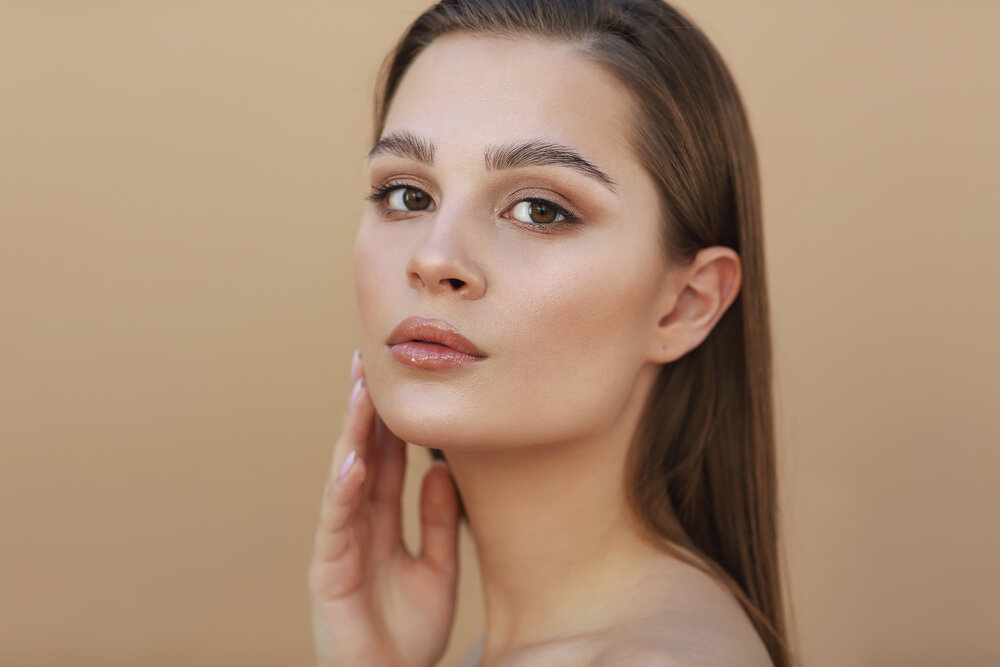
Vbeam is a pulsed dye laser (PDL) for the treatment of a wide range of skin pigmentation issues, including the common inflammatory condition rosacea. By delivering rapid bursts of light energy to the treatment area, Vbeam treatment stimulates the skin to reduce inflammation, fighting redness safely and effectively.
Santa Monica’s Derm & Rejuvenation Institute offers tailored Vbeam laser procedures for rosacea, pigmented lesions, and other common skin pigmentation issues. Find out how laser skin treatment can help you by booking a consultation with board-certified dermatologist Tanya Kormeili, MD. Call our office at (310) 526-8301, or complete a simple contact form online to request an appointment, and receive expert help for your rosacea.
Contents
Before & After
Living with Rosacea
Rosacea is a common skin condition. In fact, it is estimated that around 6% of all people in the United States have it, with that figure increasing to up to 22% in fair-skinned patients. (1) People with rosacea experience symptoms of skin flushing and rash-like reddening on the face, particularly the cheeks, nose, and forehead. Other symptoms may include small but prominent blood vessels (telangiectasia), skin thickening, papules, and eye irritation.
Rosacea is most common in women between the ages of 30-50, although men can get the condition too, and it’s often more severe. It may start as a short-term “blush” response that gradually becomes more prolonged over time. Itching, stinging, and burning sensations may also make the condition difficult to deal with, and tough to disguise. Severe rosacea can cause significant emotional distress, which can lead to social withdrawal and reduced quality of life. (2) With Vbeam treatment, patients can see significant improvements in their rosacea symptoms and find relief from its effects.
What Causes Rosacea?
Although we don’t yet know its precise cause, research suggests the following things are closely related to rosacea.
- Genetics
- Immune Reactions
- Demodex/Microorganisms
- Environmental Factors
- Neurovascular Dysregulation
- UV Exposure
There are thought to be genetic and non-genetic factors that cause rosacea. Environmental factors that contribute to rosacea flare-ups include direct sunlight, heat, stress, topical steroid use, spicy food, and alcohol, although triggers can vary from person to person. Neurovascular dysregulation refers to the faulty communication between the nervous system and the vascular system, which scientists think may also be linked to rosacea. (3)
How Does Vbeam Work?
Vbeam is a pulsed dye laser. PDLs convert light energy into heat and is one of the most effective treatments for vascular issues. A special dye is used to create the laser effect, as the light is focused on the treatment area. Targeted bursts of heat energy destroy the abnormal cells in the area of redness, but leave surrounding skin undamaged. When the skin heals, it remodels itself with significantly reduced redness.
As well as rosacea, Vbeam is effective for the following conditions.
- Acne Scars
- Age Spots
- Benign Pigmented Lesions
- Benign Vascular Lesions
- Hemangiomas
- Hyperpigmented Scars
- Port Wine Stains
- Poikiloderma
- Prominent Veins
- Psoriasis
- Red Stretch Marks
- Telangiectasia
- UC Damaged Skin
- Venous Lakes (Papules)
- Warts
- Wrinkles
Benefits of Vbeam for Rosacea
- Safe, effective treatment for many skin conditions
- Reduces or removes redness
- Causes precise, controlled tissue damage
- Encourages enhanced skin remodeling
- Stimulates collagen and elastin production
- Easy post-procedure recovery
- Long-lasting results
Research shows that laser treatments like Vbeam have revolutionized the management of rosacea. In particular, pulsed dye lasers are effective for erythematotelangiectatic rosacea, a common subtype of the condition that causes facial redness that may be resistant to other forms of treatment. (4)
Candidates
Good candidates for Vbeam treatment have rosacea or facial redness as a result of another condition, such as acne scars, visible facial blood vessels, and pigmented birthmarks. Vbeam treatment gets the most effective results in patients with fair skin who do not currently have a sun tan or a sunburn. It is not suitable in the following circumstances.
- If you are pregnant or breastfeeding
- If you have undergone Accutane treatment within the past year
- If you have active cold sores
Highly pigmented areas of skin, such as dark red birthmarks may require more than one session to get the best results. If you have had cold sores before, you may undergo Vbeam treatment with safeguards in place. With proper use of preventive antiviral medication in the days before your surgery, you can prevent treatment-associated outbreaks.
Vbeam & Darker Skin Tones
Dr. Kormeili only recommends treatments that match a patient’s needs exactly. Patients with medium-dark to dark skin tone may find that the Vbeam procedure is ineffective or more risky than others. This is because the risk of scarring/continued pigmentation issues from this kind of laser is higher in skin that contains more melanin, so the results may not be as successful. If your complexion is darker, we will be happy to suggest other treatment options, so please feel free to inquire with us!
Personal Consultation
Dr. Kormeili is Santa Monica’s leading dermatology and skin care expert. She treats many different skin conditions, as well as providing non-medical anti-aging treatments and customizable skin rejuvenation procedures. At your personal consultation, she will get to know more about you, how rosacea affects your life, and what you hope to achieve with Vbeam treatment. She will then perform a thorough skin examination, noting the size and location of any redness, swelling, or papules. She will also inquire about any day-to-day discomfort you may be experiencing. After we have collected some information about your medical history, and Dr. Kormeili has determined Vbeam to be a good match for your needs, she will arrange your first treatment session.
Preparation
There are a few things you will need to do to prepare for your Vbeam procedure.
Steer Clear of UV Light
We all know how damaging UV light is to our skin, and before laser treatment, you should refrain from any prolonged sun exposure, tanning beds, or other UV skin treatments. Similarly, after your Vbeam treatment, DR. Kormeili recommends no unnecessary sun exposure for 6 weeks after your procedure.
Skip the Alcohol
Alcohol thins the blood and may affect the success of your healing. We recommend choosing the “virgin” option from the restaurant menu, or sticking to water for a few days before your Vbeam treatment, rather than ordering any alcoholic beverages.
Avoid These Medications
Certain medications may also increase bleeding and hinder effective healing. These include NSAID pain relievers such as aspirin, ibuprofen (Motrin), and naproxen (Alieve). Certain vitamins and supplements like Vitamin E, ginkgo biloba, and green tea may also have the same effects, so avoid taking these a few days before your treatment. Dr. Kormeili may recommend staying away from these medications and supplements for a short period after your treatment.
Vbeam Procedure
The specific details of your procedure will depend on your treatment plan. Patients should be fully prepared beforehand, which means no recent UV exposure. You will not be able to receive Vbeam treatment on your planned treatment date if you have recently tanned skin, so please take care and stay out of the sun before coming to see us.
The Vbeam device is a standing system with a precision handpiece. After calibrating the device to your skin’s specific requirements, and securing your eye protection comfortably, Dr. Kormeili will focus the laser heat energy onto the treatment area in short, high-intensity bursts, while continually passing the laser over the skin. Cooling bursts from its built-in Dynamic Cooling Device will help to minimize discomfort. Vbeam is well-tolerated by the majority of patients, and most people describe the sensation as a “rubber band-like” snap on the skin.
Once your treatment is complete, Dr. Kormeili will remove your eyewear and you will be free to leave immediately after your procedure. We will ensure you have everything you need for your aftercare and a speedy skin treatment recovery!
Vbeam Recovery & Results
In the hours and days that follow, you can expect the treatment areas to redden in color. This is completely normal. You should also expect some temporary swelling. In some patients, a laser burn (known as purpura) may occur. These effects will dissipate in 3-5 days.
Over time, your skin will start to heal and generate new, collagen-rich remodeled skin after your treatment. And, once the healing process is complete, you will experience a significant reduction in rosacea redness. Depending on the severity of your condition, the results of your Vbeam treatment may last over a year!
Corresponding Procedures
IPL PhotoFacial
As an alternative to Vbeam, Derm & Rejuvenation Institute offers intense pulsed light treatment in the form of the IPL Photofacial to treat rosacea. IPL works in a similar way and can achieve similar results to pulsed dye laser treatment, so feel free to discuss the advantages and disadvantages of both modalities with Dr. Kormeili.
Chemical Peels
A Chemical Peel followed by a carefully-tailored skin care regimen can reduce rosacea redness and address other skin texture and tone issues. We can give you information on the benefits of various chemical peels for clearer skin, anti-aging, and redness reduction, just ask at your personal consultation!
Cost of Rosacea Treatment in Santa Monica
Your treatment cost will be determined after Dr. Kormeili has conducted a physical examination of your skin, and has determined how many Vbeam treatment sessions you will need to get the best results. If you’re suffering with itchiness, flushing, and redness from rosacea, call our Santa Monica office at (310) 526-8301, or fill out our convenient online form to book your personal consultation.
Get the latest dermatology news and info on the most effective skin treatments by reading the Derm & Rejuvenation Institute blog. You can also like and follow us on our social media!
FAQ
Why is my face so red sometimes?
There are many things that can cause facial redness. These include skin allergies, dermatitis, reactions to certain medications, rosacea, and various types of rash. However, if it is becoming an ongoing problem, and especially if it is accompanied by discomfort, visit your dermatologist for a thorough skin analysis and accurate diagnosis.
What’s the best treatment for rosacea?
There are many topical creams available from your pharmacy that can lessen the appearance of rosacea. However, these results are usually short-lived. In-office rosacea treatments, such as lasers and intense pulsed light (IPL) provide long-term relief from symptoms.
References
- Marchitto MC, Chien AL. Rosacea and Associated Comorbidities: A Google Search Trends Analysis. The Journal of clinical and aesthetic dermatology. 2020;13(7):36-40. Accessed January 2, 2023. https://www.ncbi.nlm.nih.gov/pmc/articles/PMC7492017/
- Menezes N, Moreira A, Mota G, Baptista A. Quality of life and rosacea: Pulsed dye laser impact. Journal of Cosmetic and Laser Therapy. 2009;11(3):139-141. doi:10.1080/14764170902741311
- Schwab VD, Sulk M, Seeliger S, et al. Neurovascular and Neuroimmune Aspects in the Pathophysiology of Rosacea. Journal of Investigative Dermatology Symposium Proceedings. 2011;15(1):53-62. doi:10.1038/jidsymp.2011.6
- Shim TN, Abdullah A. The effect of pulsed dye laser on the dermatology life quality index in erythematotelangiectatic rosacea patients: an assessment. The Journal of clinical and aesthetic dermatology. 2013;6(4):30-32. Accessed January 3, 2023. https://www.ncbi.nlm.nih.gov/pmc/articles/PMC3638853/





